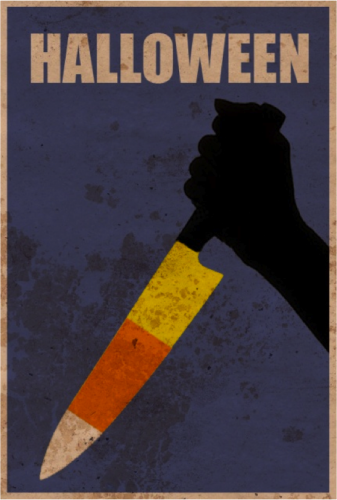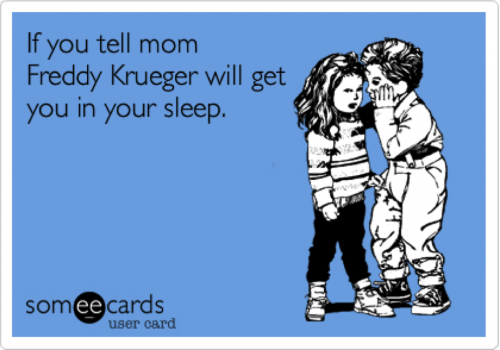
Here we go with part two of Blake Collier’s budding In the Event of a Cosmic Horror franchise. To read part one, go here.
The Slasher
Because I am a bit of a masochist, I am going to start the breakdown of horror sub genres with an analysis of the slasher film. No type of horror has been so maligned by critics, parents and Christians as the slasher flick has in the whole economy of the horror film. It appears as if the first true slasher films were made in order to prominently depict three things: killings/blood, sex/nudity and vengeance. That second factor tends to be the most objectionable to Christians, a group who, statistically speaking, frequents action movies–or action movies dressed up as historical dramas, where a significantly higher percentage of people die in brutal ways (take any Mel Gibson historical drama, for instance).
 Adam Rockoff, author of Going to Pieces: The Rise and Fall of the Slasher Film, 1978-1986, describes the nature of the slasher villain through a comparison with villains in action films:
Adam Rockoff, author of Going to Pieces: The Rise and Fall of the Slasher Film, 1978-1986, describes the nature of the slasher villain through a comparison with villains in action films:
“Slasher films don’t linger too long on the victim’s agony. Prolonged scenes of misery and suffering quickly turn off mainstream audiences . . . There are few scenes of extreme brutality, such as in the low-budget hit Reservoir Dogs (1992), in which Michael Madsen slices off a police officer’s ear and then attempts to burn him alive. Nor do the villains conjure up some elaborate diabolical plan, à la the James Bond films, to ensnare their victim. They simply go about their duty, which is killing, with systematic precision, uncaring, emotionless and unmerciful
It has become well-ingrained in the consciousness of the wider culture, to the point of being spoofed in later films like Scream (1996) and Scary Movie (2000), that the slasher villains punish the young teenager or college student for their youthful transgressions, most notably those of a sexual nature. In a majority of these films, the villains are driven by a warped sense of justice; they are seeking vengeance on those who actually victimized them or who, symbolically, represent those who transgressed against them. The Halloween series is the notable exception, but we will get to it in a bit.
I would like to propose that we abandon whatever paradigm we’ve created for the slasher film so that we might view them in a more useful and more profound interpretative framework: one in which the modern audience is facing an unknown world where Law rules and grace is non-existent. No matter how much we might take the everyday grace that surrounds the believer and the unbeliever for granted, it is present. Something restrains us from indulging our inner demons at every opportunity; matter of fact, sometimes life is quite good and even blessed. This is never the case within the fictional universe of the slasher genre. In the world of the slasher, everyone has transgressed, and all must pay.
As Rockoff described, above, the villain is void of any noticeable trace of humanity. They have no emotions, no caring, and no mercy. They are precision machines, not humans, and their “justice” is never quenched simply because people are repetitive creatures, especially concerning their sins. Within this framework, the slasher villain can be a rather dark and sinister expression of the Law. They do not understand forgiveness; instead they want propitiation for what was done against them, a.k.a. dead teenagers. And, much like the Law, no one and nothing is able to live up to the villain’s code of righteousness. The only characters that are able to escape (if only temporarily or until a sequel comes along) are those, usually female, characters that are “pure,” albeit mostly in a sexual way. However, they are far from innocent, because the villain is still coming after them; they still stand as condemned in the eyes of the slasher villain.
We who live under grace recognize how heavy the illustration of the slasher film really is. We know that, in the end, we would all be ‘dead teenagers’ under the rule of an unforgiving and condemning Law. Every transgression, minor or major, would warrant death according to the Law (and, analogically, to the slasher villain). In The New Testament, Paul’s letter to the Galatians alludes to the reality created, for humanity, by the Law as presented in Deuteronomy 27:26 when it states:
“All who rely on observing the law are under a curse, for it is written: ‘Cursed is everyone who does not continue to do everything written in the Book of the Law.’” (Gal. 3:10 NIV84)
The slasher villain is simply the manifestation of that curse in popular horror cinema.
Michael Myers, the single most iconic slasher of all, creates a monolithic image in the economy of the sub-genre. Unlike most other villains, Myers’ killing spree is unprovoked. The first Halloween shows a young Michael Myers slaying his older sister (who, it is implied, had just consummated her relationship with her boyfriend) and we are brought in to the psychology of Myers by Dr. Loomis (played by the classic Donald Pleasance) after years of Myers being contained in a mental institute. Dr. Loomis states this about Myers:
“I met him, fifteen years ago. I was told there was nothing left. No reason, no conscience, no understanding; even the most rudimentary sense of life or death, good or evil, right or wrong. I met this six-year-old child, with this blank, pale, emotionless face and, the blackest eyes… the devil’s eyes. I spent eight years trying to reach him, and then another seven trying to keep him locked up because I realized what was living behind that boy’s eyes was purely and simply… evil.”
Welcome to the description of an individual completely divorced from the restraints of God’s grace. He is “purely and simply…evil.” No man has ever been as bad as they could have been, though some, I presume, were closer than others. All other slasher villains are presupposed to have been normal, at one point, and then turned into monsters by being victimized. Myers was unrestrained evil from the beginning.
The slasher sub-genre should provoke a response from the viewer because they are forced into a world that is, to a large extent, unknown to them (echoing Thacker from Pt. 1). As the films are being viewed, the audience are brought into a world where every mistake is punishable by death. This should create a dissonance within the viewer who lives within the excesses of God’s grace in the world we all experience (and take for granted). Slasher films should be a stark reminder to us all of the realities of a world left to the unforgiving nature of the Law. And much like the Law, the slasher should point out that there is nothing we can do, in and of ourselves, that will save us from the blade. Grace could only enter Haddonfield, Camp Crystal Lake and Elm Street if Myers, Voorhees and Kruger fell on their own machetes in place of their victims. Fat chance.
[youtube=http://www.youtube.com/watch?v=17xY6OFqBJo&w=600]
As one comment on this video puts it, even Freddy spits harder rhymes than Lil’ Wayne.
Next up: The Living Dead!

COMMENTS
9 responses to “In the Event of a Cosmic Horror, Pt 2: The Slasher”
Leave a Reply















I think you give slashers too much credit. The Law as it is without the Spirit is because of that exactly, it is a slayer without the Spirit. Fundamentally, it reveals the darkness woven into our nature rather than a bogeyman chasing me around.
Slashers rather reveal a fear of a juvenile, vapid, and materialistic culture. The idols of youth, cut to pieces in pursuit of pleasure and luxury. The terror is a quick, sudden and bloody death.It is the fear of an instant gratification yuppy. Real darkness comes not from something so mechanical, but something human.
Cal
Cal, I appreciate your comments.
I agree that the Law without the Spirit is a slayer and that the Law does reveal the darkness woven into our nature rather than a bogeyman chasing us around. However, my intent was not to make the slasher villain out to be that which is revealed by the Law, but, instead, the very anthropomorphized Law: if you will, the Law made alive in its darkest element—that it does slay us for every sin/mistake we make (and that we can’t escape from it by anything we do). This is exactly what the slasher villain does. He slays those who do not live up to his inherent conception of “righteousness.” I think it is a fair interpretation to place on the genre.
On one level, I agree with your materialistic/consumer interpretations of slashers, but it is neither necessarily the most important nor the only interpretation that can be brought out from these films. Even “low art” (which I question that very dichotomy in the first place) like slasher films, can contain meaning that transcends what the filmmakers or artists meant for it to have. Art is flexible like that. I am just finding another possible interpretation which is, also, not necessarily the most important or only interpretation.
At the end of the day, people will watch these films (as is apparent by the fact that they still bring in decent profits) and, whether a person agrees with my interpretation or not, I am trying to challenge people to engage with these films instead of just going to them as mere thoughtless and pointless entertainment. I would advise people to do the same with everything from the romantic comedy to Kurosawa’s Seven Samurai to Shawshank Redemption.
I appreciate your comments though, makes me dig a little deeper as well into my own explanations.
“the idols of youth, cut to pieces”
-I agree with that, but it’s not so much a fear of loss as a fear of judgment – the extrahuman killer visiting the the guilty after teenage sex. There’s the judge of idolatry (Can I convince someone to have sex with me? or even, can I get a job?) and the underlying, deeper fear of Judgment by relativization or moral condemnation of these desires. The latter – ‘second use’, ‘fear and trembling’, etc – is the fear of judgment by a meatcleaver, or at least the divine equivalent.
-Sin and judgment are identical, in a slightly abstract (perhaps speculative) way.Let me explain:
It DOES come from something human, and something superhuman – that is to say, the sinner feels his/her evil and feels judged by it (their consciences will accuse them (Rm 1-2)). Cal, I tried to extrapolate a bit from Blake’s (incredible) piece and locate the internal divide between our desires and actions, wherein ‘falls the shadow’ (Eliot). Slashers, I think, form a unity between interior and exterior judgment – the given teenagers are often guilty/anxiety-ridden to the point that the audience isn’t surprised in the least (except perhaps by a jump cut or rapid shift in mis-en-scene) when the blade falls. The darkness in our soul both anticipates AND confirms the judgment, for my money, and slashers illustrate this unity very well (or so I’m convinced, post-Blake article). Wonderful piece – looking forward to more!
Thank you very much for your encouraging words, JAbernathy! I am glad you found it to strike a chord with you.
I love your approach to the interior and exterior judgment. Exceptionally insightful and an element that I may have nudged against, but ultimately missed in my analysis. I will have to chew on that and bring it to bear on the article as it is. Someday (sometime, somewhere) I would like to write a book and use these as illustrations or significant analogies or something! Anyways, thank you for the excellent comment and I appreciate your insightful (and in my opinion, right on) perspective about the double judgment that is unified in the slasher flick.
Blake, Great job! I might be prejudice though because I am your mom. Your dad and I are so proud of you and just wanted to let you know. Keep up the good work!